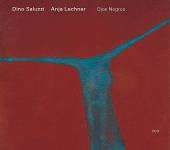Home » Jazz Articles » Album Review » Dino Saluzzi / Anja Lechner: Ojos Negros
Dino Saluzzi / Anja Lechner: Ojos Negros
These and many, many more questions are raised by Ojos Negros, the astonishing record by bandoneonist Dino Saluzzi and cellist Anja Lechner. Saluzzi's Juan Condori (ECM, 2006) was a family affair, but the music somehow managed to convey the humanity, vulnerability and wisdom of its patriarch, Dino Saluzzi.
Lechner is a member of the Rosamunde Quartett, which has an extensive ECM classical discography. She has a deep interest in many kinds of folk music, but Argentinean music has held a special place in her heart for the past twenty-five years. Her research led her to Saluzzi, with whom she has played for the last ten years, including six of duo concerts.
Thus, Lechner has been able to get inside of this music and especially become one with Saluzzi, whose music, at this point, transcends tango. The resulting performance is beyond category and might best be described as not jazz, not classical, not tango, and not folk music.
Whatever it is—and Saluzzi would say, "I play music"—its emotional impact derives from a delicate intimacy that emerges from the music's depth and breadth, which includes the sound of Saluzzi pressing his bandoneon keys. Lechner, as a playing partner, has tapped into Saluzzi's ability to communicate directly to the listener. They are talking to us, or better, we are overhearing a musical conversation with all artifice discarded, and what is left is from their hearts to ours.
In the notes, Lechner talks about how each performance could be entirely different from the last, and in more ways than just the amount of rubato, and hence the pacing of this or that phrase. What is improvised is indiscernible from what is written and the arrangement, ostensibly the form of the piece, becomes a very flexible thing that is but the starting point for the performance.
The magic of the sound of Ojos Negros, apart from the emotional intangibles, lies in the fact that nothing stands still. Saluzzi will play close chords, then contrapuntal lines, while Lechner changes registers to mix first with Saluzzi's high notes and then the low notes, or jumps back and forth from arco to pizzicato. When playing together, the caress of Saluzzi's bandoneon surrounds Lechner's singing cello.
Combine all of this with a sense of rhythm or pulse that is so refined as to make the music playfully dance, creating such a very strong sense of breathing that you might just hold yours.
Ojos Negros is another gem in the ECM catalogue of gems, and will continually show new faces and reflections no matter how many times it is heard.
Track Listing
Tango a mi Padre; Minguito; Esquina; Duetto; Ojos Negros; El Titere; Carretas; Serenata.
Personnel
Dino Saluzzi
bandoneonDino Saluzzi: bandoneon; Anja Lechner: cello.
Album information
Title: Ojos Negros | Year Released: 2007 | Record Label: ECM Records
< Previous
Redemption - Quest Live in Europe
Next >
II
Comments
Tags
Dino Saluzzi / Anja Lechner
CD/LP/Track Review
Dino Saluzzi
Budd Kopman
ECM Records
United States
Ojos Negros
For the Love of Jazz
 All About Jazz has been a pillar of jazz since 1995, championing it as an art form and, more importantly, supporting the musicians who create it. Our enduring commitment has made "AAJ" one of the most culturally important websites of its kind, read by hundreds of thousands of fans, musicians and industry figures every month.
All About Jazz has been a pillar of jazz since 1995, championing it as an art form and, more importantly, supporting the musicians who create it. Our enduring commitment has made "AAJ" one of the most culturally important websites of its kind, read by hundreds of thousands of fans, musicians and industry figures every month.




















